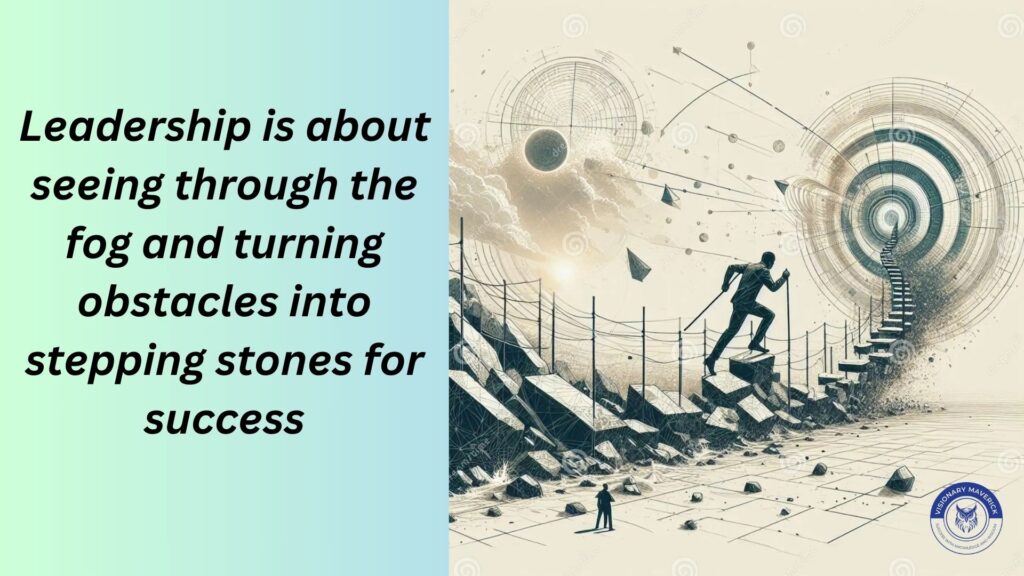
Why Business Leaders Need a Military-Inspired Approach
In today’s fast-moving world, the business landscape is like a battlefield. It’s full of constant change, intense competition, and pressure to make rapid decisions. One day, you’re celebrating a big success, and the next, an unexpected issue throws everything off course. It’s an environment where success doesn’t come from simply sticking to a plan; it comes from the ability to adapt, pivot, and stay resilient no matter what comes your way.
This level of unpredictability is something military leaders have been dealing with for centuries. The famous military strategist Carl von Clausewitz described it best with his concept of the “fog and friction of war.” He wrote, “Everything in war is simple, but the simplest thing is difficult.” For businesses, this idea rings true every day.
The Fog of Business: Navigating the Unknown
The “fog” in warfare refers to the uncertainty and lack of information that soldiers face on the battlefield. In the business world, fog is everywhere. It’s the ambiguity that comes with rapidly changing markets, evolving technologies, and unpredictable consumer behaviour. Leaders often must make critical decisions without having a complete picture. For instance, imagine a tech company deciding whether to invest heavily in a new technology. They may not know how customers will respond, how fast competitors will move, or if the market will evolve in their favour. This fog of uncertainty clouds their judgment and makes every decision feel like a leap into the unknown.
Friction: The Unexpected Obstacles Along the Way
Even if a business leader has a clear plan, friction often gets in the way. Clausewitz used “friction” to describe all the unexpected obstacles that disrupt even the best-laid plans. In the business world, friction comes in many forms like operational setbacks, resource constraints, or even internal miscommunication. Consider a company launching a new product. They might face supply chain disruptions, higher-than-expected costs, or delays in production. These are the real-world frictions that disrupt their strategy and make execution harder than anticipated. Friction is that constant reminder that things rarely go as smoothly as planned.
Why Fog and Friction Demand a New Approach
Traditional business strategies are often designed for stable conditions, assuming that market trends and competitive dynamics are somewhat predictable. But in a world where both fog and friction are constants, this approach can fall short. Conventional strategies may look great on paper but fail to provide the flexibility and resilience needed when unexpected challenges arise.
That’s where a military-inspired approach comes in. Just as military leaders use structured processes to cut through the fog and manage friction on the battlefield, business leaders can benefit from similar tools. A disciplined, systematic approach can help bring order to the chaos, allowing leaders to stay clear-headed and resilient even when things don’t go according to plan. By thinking and planning strategically, businesses can not only navigate through uncertainty but also turn these challenges into opportunities for growth and innovation.
How Military Strategy Offers a Pathway Through Fog and Friction
Military leaders have long faced the challenge of making fast, high-stakes decisions in environments full of unknowns. Imagine the intense conditions of combat, where even the best plans can be thrown off course by unexpected events. To navigate this chaos, military strategists have developed structured processes that allow them to make informed choices despite the “fog” and “friction” of war. As Carl von Clausewitz said, “War is the realm of uncertainty; three quarters of the factors on which action in war is based are wrapped in a fog of greater or lesser uncertainty.” For business leaders, this wisdom applies just as powerfully in today’s unpredictable landscape.
A Proven Approach from the Battlefield
In the military, structured planning processes are essential. Military leaders use step-by-step frameworks to assess the situation, evaluate options, and choose the best course of action—even when the ground is shifting beneath them. This structured approach creates a sense of stability amidst chaos, helping leaders make decisions quickly and confidently, knowing they’ve considered all the critical factors.
Take, for instance, how military teams prepare for missions. They don’t just plan for one scenario; they prepare for multiple outcomes, anticipating what could go wrong and building in contingencies. This proactive thinking is what allows them to adapt on the fly. By following a systematic process, they can respond effectively to changing circumstances, knowing that their team is prepared for the unexpected.
Military Precision and Preparedness for Business
The same principles that allow military teams to make effective decisions under pressure can also transform corporate strategy. Businesses today operate in a world of complex challenges—be it supply chain issues, competitive pressure, or sudden regulatory changes. Just as military leaders rely on precise, prepared strategies, corporate leaders can apply a similar level of discipline to navigate their own challenges.
For example, a company launching a product in a competitive market can use military-style planning to account for uncertainties. Instead of banking on one forecast or one set of assumptions, they can analyze multiple market scenarios, preparing strategies that allow them to pivot quickly if needed. If a competitor makes an unexpected move or market conditions shift, the company can respond swiftly without scrambling. This structured preparedness allows them to “cut through the fog” and overcome operational friction with a clear, adaptable plan.
Real-World Example: Navigating Uncertainty with Structure
A real-world example of structured decision-making in a business context is Amazon’s approach to logistics and supply chain management. Amazon operates with a strategy inspired by military precision, preparing for countless scenarios to ensure they can deliver on promises, even when unexpected disruptions occur. They anticipate everything from supplier issues to sudden spikes in demand, and they use structured processes to keep operations running smoothly. By creating multiple layers of backup options and analyzing potential disruptions ahead of time, Amazon navigates through fog and friction with confidence.
For business leaders, adopting this military-inspired approach means embracing a mindset of preparedness, where decisions are made with a full understanding of potential risks and responses. Rather than reacting to uncertainty, they can strategically plan for it, transforming unpredictability from a liability into an opportunity for resilience and growth.
What Is the MAP?
In the heat of the moment, when stakes are high and uncertainty is all around, a structured approach to decision-making can be a game-changer. This is where the Military Appreciation Process (MAP) comes in. Originally developed as a military framework, MAP is a step-by-step process designed to bring structure, clarity, and resilience to situations where leaders need to make quick, effective decisions despite complex challenges. As the renowned strategist Sun Tzu said, “Victorious warriors win first and then go to war, while defeated warriors go to war first and then seek to win.” In business, MAP helps leaders “win first” by preparing for whatever challenges may arise.
How MAP Addresses Fog and Friction
The MAP framework is uniquely suited to cutting through the “fog” of uncertainty and minimizing the “friction” of unexpected obstacles. Each step in MAP guides leaders to carefully assess their environment, consider multiple courses of action, and plan ahead for potential challenges. Rather than reacting to changes as they happen, MAP allows leaders to anticipate issues and take proactive steps to stay on course.
Let’s take a closer look at the five core steps of MAP, each one providing a layer of clarity and control.
1. Scoping and Framing: Defining the Landscape
In any complex situation, the first task is understanding the full picture. Scoping and Framing helps leaders define the landscape they’re working within, identifying key challenges, opportunities, and the limits of their resources. In a corporate context, this step is like taking a high-level view of the market landscape before launching a new product. By scoping out the environment, companies gain a clearer sense of the competition, customer expectations, and any external factors that could impact their plans.
2. Mission Analysis: Setting Clear Objectives
Once the landscape is clear, the next step is Mission Analysis. This phase is all about defining the main objective and ensuring that everyone understands the mission’s purpose. In the military, this means that every team member is aligned on the ultimate goal. In business, Mission Analysis helps teams clarify their objectives, so everyone from leadership to frontline employees knows what success looks like. For example, a retail company expanding into a new region would use this step to set clear goals, such as market share targets, customer acquisition, or brand awareness.
3. Course of Action (COA) Development: Creating Multiple Pathways
With clear objectives in place, it’s time to consider different ways to reach the goal. COA Development encourages leaders to think beyond a single solution by developing multiple, adaptable strategies. Just as military leaders create alternative tactics for various scenarios, business leaders can use COA Development to prepare for different market reactions. Imagine a tech startup launching a new app: COA Development would involve planning for rapid growth, steady adoption, or even slower-than-expected uptake, with each scenario having a specific response.
4. Course of Action Analysis (War Gaming): Testing the Options
Once different strategies have been developed, the next critical step is to test each one to identify potential strengths and weaknesses before implementation. In military terms, this phase is known as “War Gaming,” where leaders simulate various scenarios to expose vulnerabilities and fine-tune their plans. This concept is equally powerful in the business world, where we refer to it as Business War Gaming.
Business War Gaming allows leaders to play out potential competitive responses, market shifts, or internal challenges in a controlled setting, effectively “stress-testing” each plan. Imagine a company preparing to launch a new product. Through Business War Gaming, they can simulate competitor reactions, supply chain disruptions, or shifts in customer preferences, allowing them to refine their approach and prepare for the unexpected.
This step is invaluable for business leaders, providing a safe environment to identify and address potential points of friction before they become real obstacles. By analyzing how each course of action might play out, companies gain insights that strengthen their resilience and adaptability. In upcoming articles, we’ll explore Business War Gaming in greater depth, showing how this strategic tool can transform corporate decision-making and prepare organizations to navigate uncertainty with confidence.
5. Decision and Execution (CONOP): Acting with Precision
Finally, after analyzing all options, leaders reach the Decision and Execution phase, known in military terms as the Concept of Operations (CONOP). This step ensures that leaders not only make an informed decision but also communicate it clearly so the entire team is aligned and ready to act. In a business context, CONOP could be the launch phase of a product where the decision is made, roles are defined, and the plan is set into motion. By following a structured plan, leaders execute with confidence, knowing their team is prepared and every detail is accounted for.
The MAP is more than just a series of steps; it’s a disciplined approach that allows leaders to bring order to chaos. By assessing the landscape, setting clear goals, developing flexible strategies, testing their plans, and then acting decisively, leaders can navigate the fog and friction of business challenges with confidence and resilience.
Why MAP is Essential for Modern Corporate Strategy
In today’s business world, leaders face a constant barrage of complex decisions, rapid changes, and unexpected challenges. Carl von Clausewitz famously said, “In war, the simpler the plan, the better,” and the Military Appreciation Process (MAP) is a testament to this principle. MAP is designed to simplify complex situations, offering a structured approach to gain clarity, build resilience, and approach strategy with confidence.
Clarity Amidst Complexity
In times of uncertainty, clarity is one of the most valuable assets a leader can have. MAP provides a structured way to break down and analyze complex situations, helping leaders see through the “fog” of ambiguity. By carefully scoping the landscape, defining objectives, and setting clear priorities, MAP allows leaders to focus on what truly matters.
Consider a company facing a sudden industry shift, like a new regulatory change or a disruptive competitor. Without clarity, it’s easy for teams to get overwhelmed or lose direction. MAP helps these leaders cut through the confusion, bringing everyone’s attention to a clear path forward. In essence, it’s about making sense of chaos and establishing a course that aligns the entire organization.
Building Resilience Through Preparedness
Clausewitz also spoke of friction, describing it as “the force that makes the simple difficult.” In the business world, friction often comes in the form of operational hiccups, supply chain disruptions, or internal resource constraints. While these challenges can be disruptive, MAP’s framework allows leaders to anticipate and plan for potential obstacles. By preparing multiple courses of action and testing them through Business War Gaming, companies can proactively address issues before they arise.
Imagine a retailer planning for the holiday season. They know that demand will surge, but there are always uncertainties, weather disruptions, supplier delays, or even shifts in consumer behaviour. Using MAP, the retailer can analyze these potential disruptions and create backup plans, building resilience into their operations. When challenges inevitably arise, they’re ready to adapt with minimal disruption. This proactive mindset helps leaders respond with agility rather than scrambling to react.
Positioning MAP as a Transformative Tool
Ultimately, MAP is much more than just a crisis management tool. It’s a transformative approach that equips leaders to navigate all kinds of challenges, from everyday decisions to high-stakes situations. Rather than waiting for crises to hit, MAP fosters a culture of resilience, adaptability, and strategic foresight, enabling leaders to stay ahead of the curve. In a world where uncertainty is the only constant, MAP becomes invaluable, providing a structured process for thinking through problems and staying prepared, no matter what comes next.
For modern businesses, MAP offers a disciplined path through the fog and friction of today’s fast-paced markets. It’s not just a tool for surviving challenges—it’s a way to thrive in them.
Conclusion: Leading Through Uncertainty with MAP
In the face of today’s unpredictable business landscape, fog and friction are constant companions. Carl von Clausewitz once said, “Courage, above all things, is the first quality of a warrior.” But for leaders, courage alone isn’t enough. To navigate these challenges successfully, leaders need a clear, structured approach—something that provides confidence and adaptability, even when the path forward is unclear. This is where the Military Appreciation Process (MAP) shines. MAP isn’t just a framework; it’s a way to bring order to chaos, empowering leaders to tackle ambiguity and obstacles with a calm, proactive mindset.
Whether dealing with sudden market shifts, unexpected operational issues, or the challenge of staying ahead in a competitive landscape, MAP equips leaders with tools to think strategically, act decisively, and adapt as new information emerges. Through each step, MAP enables organizations to anticipate, test, and refine their strategies, making it easier to handle whatever comes next with resilience and clarity.
Explore MAP in Depth
This article is just the beginning. In the upcoming series, I’ll break down each step of the Military Appreciation Process in detail, from Scoping and Framing to Decision and Execution, highlighting how each one can bring structure and foresight to your strategic planning. Expect actionable insights and practical examples designed to help you apply MAP principles directly to your leadership challenges.
Taking the First Step
If you’re looking to lead with confidence and inspire your team, consider adopting this disciplined, military-inspired approach. MAP isn’t just a tool for crisis management; it’s a mindset that fosters resilience and strengthens your organization against the unexpected. As we continue to explore MAP together, I hope you’ll find ways to make it a part of your leadership strategy, turning uncertainty into opportunity and challenge into growth.



